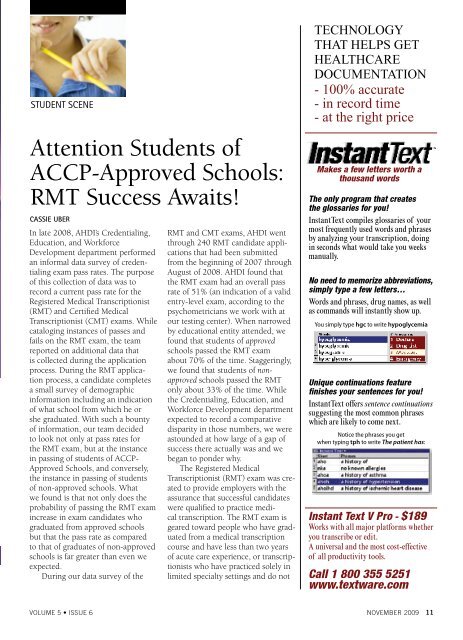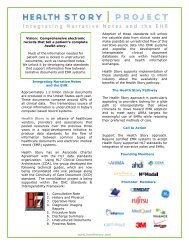Credentialing: - Association for Healthcare Documentation
Credentialing: - Association for Healthcare Documentation
Credentialing: - Association for Healthcare Documentation
Create successful ePaper yourself
Turn your PDF publications into a flip-book with our unique Google optimized e-Paper software.
STUDENT SCENE<br />
Attention Students of<br />
ACCP-Approved Schools:<br />
RMT Success Awaits!<br />
CAssie UBer<br />
In late 2008, AHDI’s <strong>Credentialing</strong>,<br />
Education, and Work<strong>for</strong>ce<br />
Development department per<strong>for</strong>med<br />
an in<strong>for</strong>mal data survey of credentialing<br />
exam pass rates. The purpose<br />
of this collection of data was to<br />
record a current pass rate <strong>for</strong> the<br />
Registered Medical Transcriptionist<br />
(RMT) and Certifi ed Medical<br />
Transcriptionist (CMT) exams. While<br />
cataloging instances of passes and<br />
fails on the RMT exam, the team<br />
reported on additional data that<br />
is collected during the application<br />
process. During the RMT application<br />
process, a candidate completes<br />
a small survey of demographic<br />
in<strong>for</strong>mation including an indication<br />
of what school from which he or<br />
she graduated. With such a bounty<br />
of in<strong>for</strong>mation, our team decided<br />
to look not only at pass rates <strong>for</strong><br />
the RMT exam, but at the instance<br />
in passing of students of ACCP-<br />
Approved Schools, and conversely,<br />
the instance in passing of students<br />
of non-approved schools. What<br />
we found is that not only does the<br />
probability of passing the RMT exam<br />
increase in exam candidates who<br />
graduated from approved schools<br />
but that the pass rate as compared<br />
to that of graduates of non-approved<br />
schools is far greater than even we<br />
expected.<br />
During our data survey of the<br />
RMT and CMT exams, AHDI went<br />
through 240 RMT candidate applications<br />
that had been submitted<br />
from the beginning of 2007 through<br />
August of 2008. AHDI found that<br />
the RMT exam had an overall pass<br />
rate of 51% (an indication of a valid<br />
entry-level exam, according to the<br />
psychometricians we work with at<br />
our testing center). When narrowed<br />
by educational entity attended, we<br />
found that students of approved<br />
schools passed the RMT exam<br />
about 70% of the time. Staggeringly,<br />
we found that students of nonapproved<br />
schools passed the RMT<br />
only about 33% of the time. While<br />
the <strong>Credentialing</strong>, Education, and<br />
Work<strong>for</strong>ce Development department<br />
expected to record a comparative<br />
disparity in those numbers, we were<br />
astounded at how large of a gap of<br />
success there actually was and we<br />
began to ponder why.<br />
The Registered Medical<br />
Transcriptionist (RMT) exam was created<br />
to provide employers with the<br />
assurance that successful candidates<br />
were qualifi ed to practice medical<br />
transcription. The RMT exam is<br />
geared toward people who have graduated<br />
from a medical transcription<br />
course and have less than two years<br />
of acute care experience, or transcriptionists<br />
who have practiced solely in<br />
limited specialty settings and do not<br />
voLUME 5 • ISSUE 6 novEMBER 2009<br />
11



